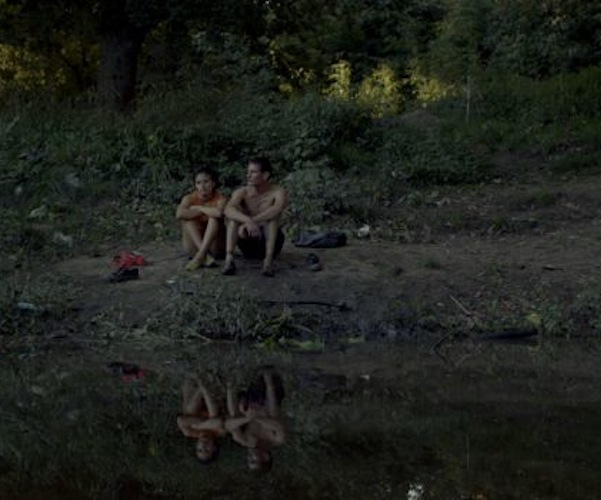Fuse Film Review: “History of Fear” — From Argentina, At High Volume
One leaves History of Fear feeling that the director wants to stir up our anxiety about the omnipresence of fear itself.
History of Fear, screening at Museum of Fine Arts Boston’s New Latin American Cinema, Boston, MA, on March 18.

A scene from “History of Fear,” screening at the MFA this Wednesday.
By Paul Dervis
The predominant takeaway from Benjamin Naishtat’s new film, History of Fear is supplied by the soundtrack. From the opening scene right to the closing credits, this movie attacks the eardrums with ferocity. Obviously, the director is trying to engulf the audience (at least sonically) in the same way his nightmare vision of Argentinian society engulfs his characters. But does it work?
Well, the structure of the film gives little room for its inhabitants to grow, or at least grow on the viewer. At times it is actually difficult to tell these characters apart, let alone follow their separate stories. What are their relationships with each other? Where are they coming from? Where are they going? Their back stories are pretty well non existent, not to mention the logic of the narrative.
Confusion reigns.
I believe that is the point. But it is a point that the viewer gets very quickly. And where does he and she supposed to go from there?
The plot, if it can be deciphered, chronicles 24 hours in the life of suburban Buenos Aires. It is a stiflingly hot day. A rundown neighbourhood is being evacuated. Fires, most likely set by the area’s poor, are raging. Smoke fills the air. Power outages are the norm. People are behaving…weirdly. People living in an affluent gated community — separated from the decrepit section only by a park — become fearful. For good reason? We are never sure.
Strange has become the new normal. A young man, while waiting in line at a food court in an amusement park, suddenly crouches to the ground and starts gyrating. A naked man, holding a paper bag, stops a car at a toll booth. An alarm goes off in a home for no apparent reason. A man rings a doorbell and attempts to enter an apartment, claiming to be someone he is not. People are trapped in stalled elevators. Threat is pushed front and center in each and every scene, but we never see anything violent take place.
Then there is the decibel level of the film…at times it almost hurts to listen. The opening shot is taken from a helicopter hovering over the slum. A faceless official tells the residents to leave their homes by order of the government. The voice is broadcast over a deafening and scratchy P.A. system that reverberates (at random) with numbing feedback. The alarm in a well-to-do house incessantly rings as the resident talks with the rent-a-cop. Someone on the second floor balcony of an apartment building is firing round after round from a gun at old ladies and young children: the ear-piercing pops of the shots are deafening…but nobody gets hit.
The images are blaring and monochromatic as well. People swim in a murky pond. The sky is blanketed in smog. History of Fear is so monolithically gray that at times you forget that this is a color film. And nobody ever smiles. Subtlety is not on this film’s agenda.
So just what is Naishtat up to with this bombastic assault of sound and fury? It is is difficult to tell what he is targeting. Of course, Argentina has had both social and political conflict off and on for the past century. But if the writer/director is alluding to any specific horror in his country’s history he does an effective job of keeping it to himself. He successfully creates an unnerving ‘Big Brother’ environment; helicopters stuffed with gun-toting soldiers fill the skies while private security forces roam the streets. But, curiously, this kind of macho muscle does not feel to be the real threat.
He also creates a sharp divide between the leisure class and the working class, and he generates some drama out of the clash of the classes. But there’s not much of a payoff.
One is left with the sense that the filmmaker wants to stir up our anxiety about the omnipresence of fear itself. The problem with that idea is that its success depends on the strength of the characters. In order to make us grapple with our own overwhelming feelings of fear, Naishtat needed to make us feel for his subjects in some way, to at least find his figures interesting, if not worthy of our empathy. But his characters are either too simple or demented to engage us. They are little more than the sum of their fears, and that is not enough to make us care.
Note to Naishtat: next time, please turn down the volume.
Paul Dervis has been teaching drama in Canada at Algonquin College as well as the theatre conservatory Ottawa School of Speech & Drama for the past 15 years. Previously he ran theatre companies in Boston, New York, and Montreal. He has directed over 150 stage productions, receiving two dozen awards for his work. Paul has also directed six films, the most recent being 2011’s The Righteous Tithe.
Tagged: Benjamin Naishtat, History of Fear, Museum of Fine Arts Film, New Latin American Cinema Series
